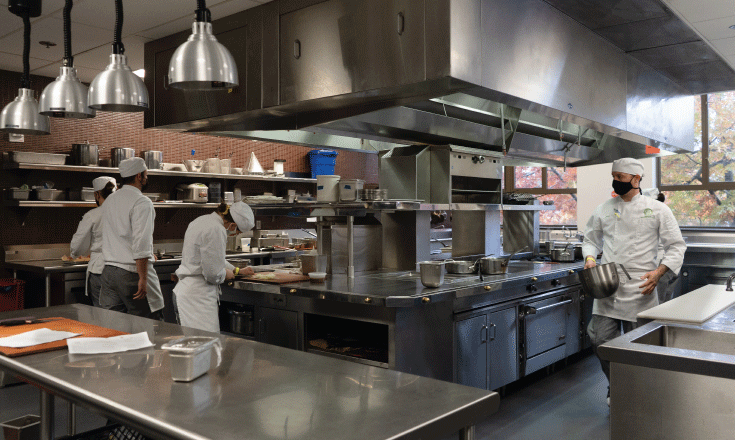On October 15, Katherine Kehrli, Associate Dean of the Seattle Culinary Department, emailed the department’s faculty, asking them not to respond to questions from the Seattle Collegian journalist, Alexa Villatoro, who’d been working on a story about budget cuts and the possible closure of Central’s culinary arts program. Kerhli instructed faculty to “refer all media inquiries directly to the PIO”, CC’ing the Public Information Officer (PIO), Roberto Bonaccorso.
“You may be receiving inquiries from the Collegian,” Kerhli told faculty. “Alexa has reached out to me several times.” In response, one culinary faculty member, Chef Kären Jurgenson, responded that it was too late.
“I talked to her yesterday,” Jurgenson explained, referring to Villatoro. Jurgenson added that she couldn’t imagine why information regarding possible budget cuts or program closures “should be a secret.”
“None of it is a secret,” Kehrli responded, “just standard operating procedure.”
Bonaccorso wrote back to affirm that they weren’t keeping secrets. Rather, he went on, the directive was about “coordinating our response.” Jurgenson responded that she was “kind and professional” in her responses to Villatoro’s questions. “I was also honest,” she added.
Minutes later, Bonaccorso responded. “The problem,” he wrote, “is that this is a student journalist.” He went on to say that Villatoro “has run stories before with inaccurate and incomplete information, mostly from sources that are not up to date with the latest information.”
Bonaccorso assured Jurgenson that they weren’t being dishonest. “We just need to be sure our information is complete and accurate,” he wrote, concluding that “we need to channel media questions to my office, so I can coordinate with the cabinet and president.”
Wary of the potential for censorship, Jurgenson reached out to local representatives of the American Federation of Teachers, Seattle Central’s faculty union, where she learned that faculty may speak freely without censorship. She also looked up the Washington Administrative Code governing student journalism, which affirms the first amendment rights of student journalists “to promote free and responsible discussion of campus and community issues.”
Then Jurgenson wrote back to Kehrli and her fellow instructors, informing them that they could speak with journalists. A few days later, she wrote to Bonaccorso, expressing her “right to speak freely.” She went on to say that “if administration wants to co-ordinate a response, they can do so.” She also defended Villatoro, characterizing her as “a young person in search of the truth.” She asserted that the student journalist was “learning and finding her way,” and that “I must believe that she will tell the stories to the best of her ability.”
When the Collegian asked Bonaccorso to clarify Villatoro’s mistakes, he responded, “I have spoken with Alexa directly about which stories needed to be corrected.” Villatoro asserted that quick corrections were made in response to the inaccuracies Bonaccorso referenced.
In response to Kehrli’s email to faculty, Villatoro said, “I’m a learning student, and if administrators want to ensure that I’m portraying everything accurately, I would have expected some more communication.”
Kehrli said she comes from the private sector where there are often strict guidelines when communicating with the press. She also said she inquired about the preferred protocol with Bradley Lane, Executive Vice President for Instruction, and Bonaccorso before not responding to requests from Villatoro. Kehrli also stated she felt her response to Villatoro would have matched that of Lane, who had already responded. Villatoro said Kehrli shouldn’t have assumed that Lane’s comments were sufficient.
After the Collegian reached out to Kehrli for comment, she emailed an apology to Villatoro. In the email, Kehrli explained that The Seattle Times had recently written an article on a bread donation project she had organized, creating an “avalanche of interest,” causing her time to stretch thin. “I’ve been triaging my work email for the most important items,” the administrator wrote. She added, “I’m sensing that has caused the appearance of trying to hide. That is not the case.”
When asked about the suspicion of secrecy, Bonaccorso insists that administrators have been cooperative with the community and Collegian “at every stage of the difficult process of program review.” Additionally, the information officer posited that “there is nothing wrong” with directing media queries to the PIO. Bonaccorso continued, “everyone on campus has a right to speak freely and with whomever they want, but not everybody can speak on behalf of the college.”
Villatoro stressed that a lack of response from multiple administrators has left many questions unanswered. “It seems to me like there’s not enough respect for student voices,” she said. “I feel like certain things are indicated to our readership when people don’t respond.” She emphasized, “I think we deserve a little more as journalists and students, because we’re experiencing the effects of this, too.”
Author

Harlow Poffenberger is a Visual Media student at Seattle Central College where she works as an editor at The Seattle Collegian and curates the weekly ART SPACE column. Harlow also likes thru-hiking, traveling, and other adventurous pursuits, and once lived in a house with a bear.












Be First to Comment